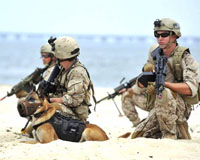 |
Washington (AFP) May 9, 2011 Pakistan or other countries may not have much to learn from the wreckage of a "stealth" US helicopter used in the raid on Osama bin Laden's compound, a defense analyst said Monday. The helicopter went down in a hard landing during last week's raid that killed bin Laden, and US Navy commandos destroyed the chopper before departing the residence in Abbottabad, north of Islamabad. CIA Director Leon Panetta and other officials have said that Blackhawk helicopters were used in the operation but photographs of the wreckage have fueled intense speculation that the aircraft was altered -- or was an entirely new model -- to reduce noise and avoid detection by radar. "The helicopter is a modified Blackhawk that is designed to maximize the chance for surprise in conducting special operations," said Loren Thompson, an aerospace analyst and head of the Lexington Institute. But he said that the technology and design features to enable an aircraft to reduce noise and evade radar are not shrouded in secrecy. Countries that examine the wreckage "will not learn much from the remnants of the exploded helicopter that were not already readily available in open literature," Thompson told AFP. "The techniques of achieving low maneuverability, or stealth as it's popularly known, are fairly well understood." Both professional and amateur aviation experts are poring over online photos of the damaged helicopter, which show a tail section with a different design than a standard MH-60 Blackhawk. A helicopter with stealth features would have helped the American special forces' team avoid detection by the Pakistanis, who were not informed of the Bin Laden raid in advance. The helicopter appears to have at least five blades in its tail rotor, instead of the four associated with the Blackhawk, which analysts said could possibly allow for a slower rotor speed to reduce noise. A cover on the rotor, akin to a hubcap, can also be seen as well as harder edges in the design, similar to the lines on stealth fighter planes such as the F-117. The cover on the rotor and the design lines would presumably be aimed at circumventing radar, according to analysts. "If you're going to try to disguise the location of the helicopter, the main thing you focus on is the noise generated by the rotors, the heat emitted by the engines, and the reflectivity of the skin and the rotors when a radar signal hits them," said Thompson, whose institute receives funding from defense firms. The Pentagon declined to comment in any way on the secret helicopter. "We are not talking about it," spokesman Colonel Dave Lapan told reporters on Monday. Asked if US officials had asked their Pakistan counterparts to return the remnants of the helicopter to the United States, he said: "We're not discussing what we are doing with that helicopter and any discussion we may be having with the Pakistanis."
Share This Article With Planet Earth
Related Links The latest in Military Technology for the 21st century at SpaceWar.com
 Dog of war in bin Laden mission is breed apart
Dog of war in bin Laden mission is breed apartWashington DC (AFP) May 09, 2011 The raid that took down Osama bin Laden is thought to have involved one special operative - a highly-trained military dog, part of an elite corps not to be confused with a family pet. The US military has refused to confirm if a dog was involved in Monday's helicopter-borne mission deep inside Pakistan, but those familiar with military dogs said only an animal with special breeding and trai ... read more |
|
| The content herein, unless otherwise known to be public domain, are Copyright 1995-2010 - SpaceDaily. AFP and UPI Wire Stories are copyright Agence France-Presse and United Press International. ESA Portal Reports are copyright European Space Agency. All NASA sourced material is public domain. Additional copyrights may apply in whole or part to other bona fide parties. Advertising does not imply endorsement,agreement or approval of any opinions, statements or information provided by SpaceDaily on any Web page published or hosted by SpaceDaily. Privacy Statement |